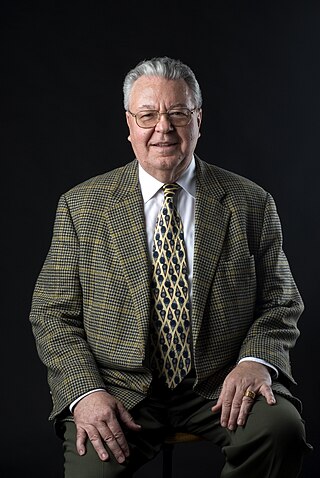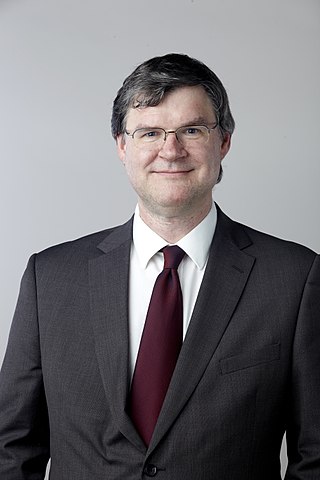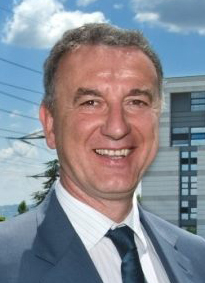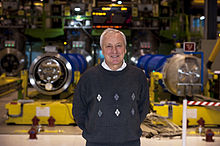
The European Organization for Nuclear Research, known as CERN, is an intergovernmental organization that operates the largest particle physics laboratory in the world. Established in 1954, it is based in Meyrin, western suburb of Geneva, on the France–Switzerland border. It comprises 23 member states. Israel, admitted in 2013, is the only non-European full member. CERN is an official United Nations General Assembly observer.

The Tevatron was a circular particle accelerator in the United States, at the Fermi National Accelerator Laboratory, east of Batavia, Illinois, and was the highest energy particle collider until the Large Hadron Collider (LHC) of the European Organization for Nuclear Research (CERN) was built near Geneva, Switzerland. The Tevatron was a synchrotron that accelerated protons and antiprotons in a 6.28 km (3.90 mi) circumference ring to energies of up to 1 TeV, hence its name. The Tevatron was completed in 1983 at a cost of $120 million and significant upgrade investments were made during its active years of 1983–2011.

The Large Hadron Collider (LHC) is the world's largest and highest-energy particle collider. It was built by the European Organization for Nuclear Research (CERN) between 1998 and 2008 in collaboration with over 10,000 scientists and hundreds of universities and laboratories across more than 100 countries. It lies in a tunnel 27 kilometres (17 mi) in circumference and as deep as 175 metres (574 ft) beneath the France–Switzerland border near Geneva.

Robert Aymar was the Director General of CERN (2004–2008), serving a five-year term in that role.

Don Lincoln is an American physicist, author, host of the YouTube channel Fermilab, and science communicator. He conducts research in particle physics at Fermi National Accelerator Laboratory, and was an adjunct professor of physics at the University of Notre Dame, although he is no longer affiliated with the university. He received a Ph.D. in experimental particle physics from Rice University in 1994. In 1995, he was a co-discoverer of the top quark. He has co-authored hundreds of research papers, and more recently, was a member of the team that discovered the Higgs boson in 2012.

Guido Tonelli is an Italian particle physicist who was involved with the discovery of the Higgs boson at the Large Hadron Collider. He is a professor of General Physics at the University of Pisa (Italy) and a CERN visiting scientist.

David George Charlton is Professor of Particle Physics in the School of Physics and Astronomy at the University of Birmingham, UK. From 2013 to 2017, he served as Spokesperson of the ATLAS experiment at the Large Hadron Collider at CERN. Prior to becoming Spokesperson, he was Deputy Spokesperson for four years, and before that Physics Coordinator of ATLAS in the run-up to the start of collision data-taking.

Sir Tejinder Singh Virdee,, is a Kenyan-born British experimental particle physicist and Professor of Physics at Imperial College London. He is best known for originating the concept of the Compact Muon Solenoid (CMS) with a few other colleagues and has been referred to as one of the 'founding fathers' of the project. CMS is a world-wide collaboration which started in 1991 and now has over 3500 participants from 45 countries.

Peter Jenni, is an experimental particle physicist working at CERN. He is best known as one of the "founding fathers" of the ATLAS experiment at the CERN Large Hadron Collider together with a few other colleagues. He acted as spokesperson of the ATLAS Collaboration until 2009. ATLAS is a world-wide collaboration which started in 1992 involving roughly 3,000 physicists at 183 institutions in 38 countries. Jenni was directly involved in the experimental work leading to the discoveries of the W and Z bosons in the 1980s and the Higgs boson in 2012. He is (co-)author of about 1000 publications in scientific journals.
The Circular Electron Positron Collider (CEPC) is a proposed Chinese electron positron collider for experimenting on the Higgs boson. It would be the world's largest particle accelerator with a circumference of 100 kilometres (62 mi).

The Large Hadron Electron Collider (LHeC) is an accelerator study for a possible upgrade of the existing LHC storage ring - the currently highest energy proton accelerator operating at CERN in Geneva. By adding to the proton accelerator ring a new electron accelerator, the LHeC would enable the investigation of electron-proton and electron-ion collisions at unprecedented high energies and rate, much higher than had been possible at the electron-proton collider HERA at DESY at Hamburg, which terminated its operation in 2007. The LHeC has therefore a unique program of research, as on the substructure of the proton and nuclei or the physics of the newly discovered Higgs boson. It is an electron–ion collider, similar to the plans in the US and elsewhere, although the present design would not include polarized protons.
Horst Artur Wenninger was a German physicist who spent most of his career at CERN, later for the FAIR project.

Lucio Rossi is an Italian physicist who is working in the field of superconductivity. He has been working since 2001 at CERN, on leave from the University of Milan, where he directed the Magnets & Superconductors for the LHC project, worth €1.7 billion, half of the machine's entire budget. He was the project leader of the HL-LHC project.

The Future Circular Collider (FCC) is a proposed particle accelerator with an energy significantly above that of previous circular colliders, such as the Super Proton Synchrotron, the Tevatron, and the Large Hadron Collider (LHC). The FCC project is considering three scenarios for collision types: FCC-hh, for hadron-hadron collisions, including proton-proton and heavy ion collisions, FCC-ee, for electron-positron collisions, and FCC-eh, for electron-hadron collisions.
The Richard Glazebrook Medal and Prize is awarded annually by the Institute of Physics to recognise leadership in the field of physics. It was established in 1966 and named in honour of Sir Richard T. Glazebrook, the first president of the Institute of Physics. It was originally a silver medal with a £250 prize.
Stephanie A. Majewski is an American physicist at the University of Oregon (UO) researching high energy particle physics at the CERN ATLAS experiment. She worked as a postdoctoral research associate at the Brookhaven National Laboratory prior to joining the faculty at UO in 2012. She was selected for the Early Career Research Program award of the U.S. Department of Energy (DOE), one of 35 scientists in all DOE-supported fields to receive this national honor in 2014.
The Linear Collider Collaboration (LCC) is an organization designated by the International Committee for Future Accelerators (ICFA) to coordinate global research and development efforts for two next-generation particle physics colliders: the International Linear Collider (ILC) and the Compact Linear Collider (CLIC). The mission of the LCC is to facilitate decisions that the next collider "will be built, and where". Members of the collaboration include approximately 2000 accelerator and particle physicists, engineers and other scientists.
Michel Della Negra is a French experimental particle physicist known for his role in the 2012 discovery of the Higgs Boson.
Tulika Bose is a professor of physics at the University of Wisconsin-Madison, whose research focuses on developing triggers for experimental searches of new phenomena in high energy physics. Bose is a leader within the Compact Muon Solenoid (CMS) experiment, a CERN collaboration famous for its experimental observation of the Higgs boson in 2012.
David M. Strom is an experimental high energy particle physicist on the faculty of the University of Oregon.













